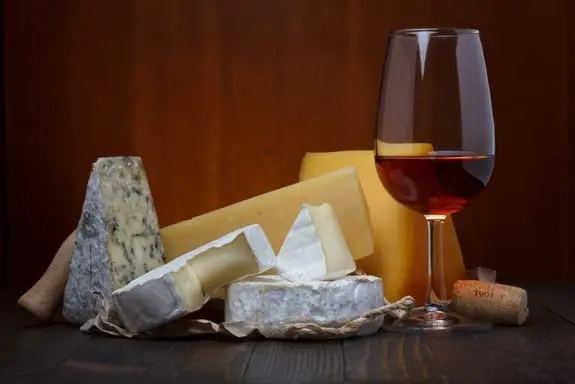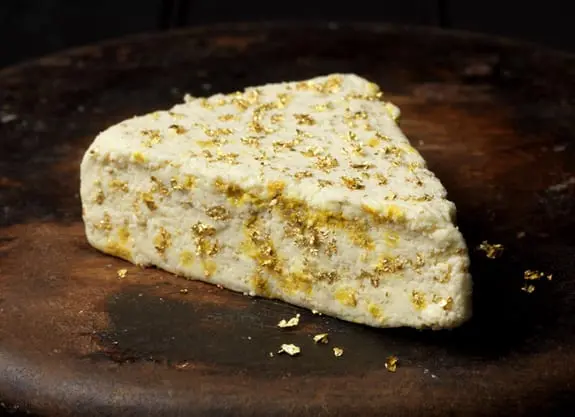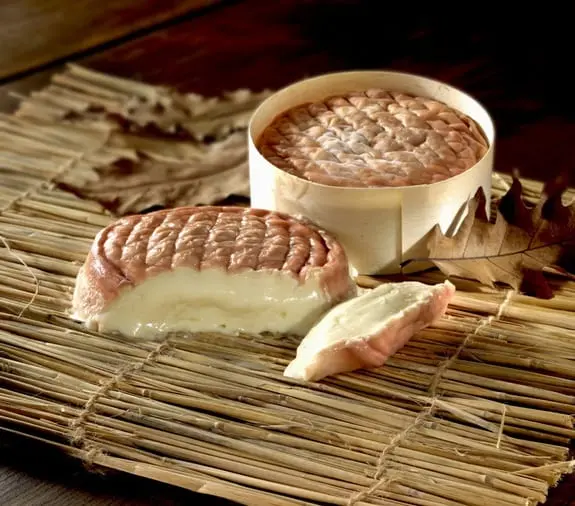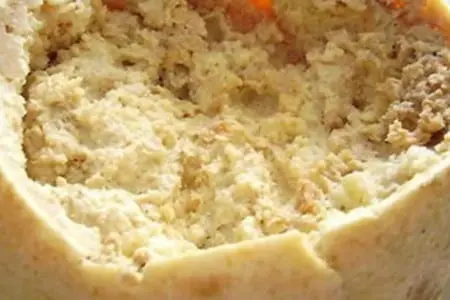According to the most conservative estimates, today there are more than 2000 different varieties of cheese in the world. Among this exuberant variety, there are exceptional specimens with a signature twist, striking in their appearance alone.

Half a kingdom for cheese
The union of noble metal and no less noble British cheese Stilton gave birth to a creation called Clawson Stilton Gold. This is a unique delicacy, stuffed with flakes of real gold in 24 carats. According to the manufacturers, this filling is quite edible and even useful for the body. The cost of the masterpiece is just under $ 100 per 100 grams, which is 67 times more expensive than the classic white Stilton without jewelry additives. It is noteworthy that this cheese, beloved by many Britons, is made in three counties. However, the farmers of the village of Stilton are strictly forbidden to produce cheese under the same name, since it does not belong to any of the “cheese” counties.

Serbian cheesemakers have surpassed their English counterparts and presented gourmets around the world with Pule cheese, made from the milk of donkeys of a special Balkan breed. In order to get a kilogram of refined product, you need 25 liters of selected milk and an inexhaustible supply of patience. The cheesemakers estimated their hard work at $ 1,700 for half a kilo of cheese. But to try it, you will have to go straight to Serbia, to the Zasavica nature reserve, where the cheese is made – you can’t find it in an ordinary supermarket.
Oddly enough, the title of the most expensive went to the cheese made from sheep’s milk without any exclusive ingredients at the usual Spanish cheese factory of Jesus Ansola Juaristi. A half-kilogram cheese head went under the hammer at one auction for 6,400 euros. The paradox is that the same cheese can be purchased at the nearest market, paying only 50 euros per kilogram. The owner of an exclusive cheese lot was the owner of a quite ordinary Spanish restaurant. With this extravagant gesture, he hoped to attract as many customers as possible.
Aroma test
Among the many tastes of Napoleon Bonaparte, there was also a place for the cheese Epoisses. It is prepared from unpasteurized cow’s milk, after which it is kept in cognac for some time. The only, but very noticeable drawback of cheese is a specific smell. The most harmless comparison is the fragrance exuded by a person who has forgotten about the existence of a shower for several months. For this reason, in France, it is forbidden to transport odorous cheese on public transport.

Meanwhile, it boasts a rich history that dates back to the 16th century. It was then that the few monks of the Cistercian community migrated to the village of Epuas, where they came up with an original recipe for cheese. They generously shared the secrets of cooking with the peasants of neighboring villages, who eventually improved the technology. By the 19th century, cheese had become incredibly popular in Paris and was sold everywhere. And by the beginning of 1900, Epoisses was successfully producing about three hundred cheese factories throughout France. Today, cheese is still revered by true gourmets, who are ready to tolerate a disgusting smell for the sake of a unique taste.
To compete in the stench with this cheese could well be “fragrant” Vieux Lille. Its stunning bouquet is eloquently warned by the man in a gas mask depicted on the label and the second name “puant macere”, which translates as”fetid brine”. If you prefer dense cheeses with a pronounced tart salty taste and are absolutely indifferent to odors, Vieux Lille will definitely appeal to you. Only you will have to transport it to the tasting place exclusively by private transport.
Starve the worm?
Fans of all sorts of extravagances will also find something to treat themselves to. You can start with the famous Casu marzu, which means “rotten cheese”. No poetic allegories, just the hard truth-the cheese is literally crawling with maggots. Prepare this work of cheese art in Sardinia from ordinary sheep’s milk. The cheese is exposed to the rays of the sultry Mediterranean sun and wait for the cheese flies to love the paradise and lay their eggs there. Soon the hatched and matured larvae are taken with an appetite to eat the cheese flesh, not forgetting to liberally flavor it with a special acid. It is under its influence that fats are broken down, and Casu marzu gets an amazing softness.

High-quality and fresh cheese is considered exactly as long as the larvae are alive and healthy – it is with them that it is served to the table. However, before the meal, it will not be superfluous to work out the skills of quick reaction. Restless larvae often jump out from the surface of the cheese at very impressive distances and can accidentally land in the face of the taster or his neighbor. If desired, of course, you can get rid of the legitimate inhabitants of the cheese, but experts say that with them will go a delicious taste.
But for those who can’t be fooled by the worms dancing on the cheese, you should definitely try the Milbenkäse cheese, originally from the German Wurchwitz. Its signature ingredient is authentic dust mite excrement. Living comfortably in the cheese halls, ticks intensively secrete a special enzyme. Depending on the duration of its exposure, the cheese changes color: a month later it gets quite the usual yellow color, after three months it becomes dark brown, and after a whole year-black. You can enjoy the taste of the product in all three guises, if you do not think about the method of its production for a long time. Some people claim that Milbenkäse has healing properties and is able to treat the most neglected ailments.
We hope that the immersion in the world of cheese madness went well, and the love for your favorite product has not faded. For those who are eager to personally taste some of the presented gastronomic curiosities, we wish you good luck and bon appetit.









